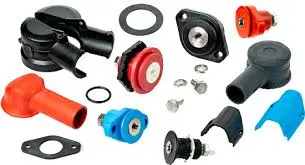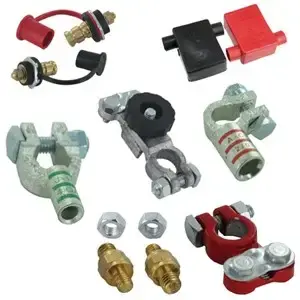Battery terminal connectors are vital in establishing a secure and efficient connection between a battery and an electrical system. These connectors serve as the crucial link that enables the battery to transmit power to various devices and equipment.
This comprehensive guide will explore the different types of battery terminal connectors available in the market and tips for choosing the correct connector for your specific needs. Additionally, we will delve into connecting battery terminals, providing you with a clear understanding of the steps involved.
Part 1. What are battery terminal connectors?

Battery terminal connectors are essential to create secure electrical connections between batteries and other devices or systems. Typically, manufacturers make these connectors out of conductive materials like copper or brass, which help facilitate the flow of electricity. They ensure that power flows smoothly from the battery to whatever it’s powering, whether a car, a flashlight, or a remote-controlled toy. These connectors come in different shapes and sizes. Still, all serve the same purpose of ensuring electricity can travel where it needs to go without interruptions. Without proper terminal connectors, batteries couldn’t power our favorite gadgets reliably.
Part 2. Battery terminal connector types
1. Post Terminal Connectors
Post-terminal or stud terminal connectors are among the most common battery connectors. They feature a threaded stud that securely attaches to the battery terminal. People commonly use this connector type in automotive, marine, and industrial applications.
2. Lugs Terminal Connectors
Lug terminal connectors have a U-shaped design, resembling a lug or a spade. They are typically made of copper or aluminum and are available in various sizes. People often use lug connectors in heavy-duty applications, such as electric vehicles, renewable energy systems, and industrial machinery.
3. Clamp Terminal Connectors
Clamp terminal connectors, or alligator clips, are characterized by their spring-loaded jaws that can easily clamp onto battery terminals. People widely use them in automotive applications, battery chargers, and testing equipment. Clamp connectors provide a quick and temporary connection, making them convenient for testing and diagnostic purposes.
4. Ring Terminal Connectors
Ring terminal connectors feature a circular ring-shaped terminal that can be easily attached to a battery post or stud. These connectors are commonly used in automotive, marine, and electrical systems where a secure and long-lasting connection is required. Ring terminal connectors are available in different sizes and materials to accommodate various wire gauges and applications.
5. Flag Terminal Connectors
Flag terminal connectors, or blade terminals, have a flat, rectangular-shaped terminal with holes for attaching wires. People often use them in automotive applications, such as connecting wires to fuse boxes, switches, and relays. Flag terminal connectors are secure and easy to install and remove.
6. Splice Terminal Connectors
As the name suggests, splice terminal connectors serve to splice or join two or more wires. People commonly use them in electrical installations, automotive wiring, and DIY projects. Splice connectors come in various types, including crimp-on, heat-shrink, and twist-on connectors, providing different levels of reliability and insulation.

Part 3. Tips for choosing battery terminal connectors
When selecting battery terminal connectors, it’s essential to consider the following factors:
- Application: Determine the specific application and electrical requirements for your project. Different applications may require different types of connectors to ensure compatibility and optimal performance.
- Material: Choose connectors made from high-quality materials such as copper or brass, which offer good conductivity and durability. Avoid connectors made from low-quality materials that may corrode or degrade over time.
- Wire Size: Consider the wire gauge or size used with the connector. Ensure the terminal connector is compatible with the wire size to establish a proper and secure connection.
- Environment: Assess the environmental conditions where you will use the connectors. Factors such as temperature, moisture, and exposure to chemicals or vibrations can affect the performance and lifespan of the connectors. Select connectors that are suitable for the specific environmental conditions.
- Ease of Installation: Choose connectors that are easy to install and provide a secure connection. Some connectors may require specialized tools or techniques for installation, so consider the available resources and expertise.
- Safety: Ensure that the selected connectors meet safety standards and regulations. Look for connectors with features like insulation, strain relief, and protection against short circuits or accidental disconnections.
Part 4. How are battery terminals connected?
Here’s a simple guide to connecting battery terminals:
- Preparation: Ensure that the battery and the electrical system are turned off or disconnected to prevent accidents or short circuits.
- Select the Connector Type: Choose the appropriate terminal connector based on the type of battery terminals and the application. Common types include top post connectors, side post connectors, ring terminals, and clamp connectors.
- Terminal Cleaning: Clean the battery terminals and connectors using a wire brush or terminal cleaner to remove any corrosion or dirt.
- Position the Connector: Place the connector over the battery terminal, ensuring it aligns correctly with its polarity (positive or negative).
- Secure the Connector: Use the provided hardware, such as bolts or screws, to secure the connector in place. Tighten the hardware securely to ensure a stable connection.
- Check the Connection: Once the connector is secured, gently tug it to ensure it’s firmly attached to the battery terminal. Verify that there are no loose connections or signs of instability.
- Test the Connection: After connecting the terminals, test the battery to ensure proper functionality. This may involve starting a vehicle, powering up a device, or using a multimeter to measure voltage.
Part 5. FAQs
-
What is the L-type battery terminal?
The L-type battery terminal has a specific design of a battery terminal connector shaped like the letter “L.” It is commonly used in automotive and marine applications, providing a secure connection between the battery and electrical components. -
What is the most widely used type of battery terminal?
The most widely used type of battery terminal is the top post connector. It is commonly found in automotive batteries and features a simple design with a post that protrudes from the battery’s top. This type of connector is easy to install and provides a stable connection. -
Do you connect red or black first on the battery?
Connecting the red positive terminal first when connecting a battery is recommended. This helps to prevent accidental short circuits and ensures a safer connection process. -
Which battery terminal do I connect to first?
When connecting a battery, it is best practice to connect the positive terminal first, followed by the negative terminal. This sequence minimizes the risk of electrical shock or damage to equipment.
Related Tags:
More Articles

Overview of Deep Cycle Lithium Battery
In this article, we explore the life, voltage, capacity, and charging considerations of deep cycle lithium batteries.
How Long do Lithium Batteries Last?
How long do lithium batteries last? we will explore the factors that influence the lifespan of lithium batteries and provide insights into their longevity.
How to Choose the Best LiFePO4 Battery?
Choose LiFePO4 batteries for superior performance, safety, and versatility in EVs, UPS, and backup power. This guide helps you make informed decisions.
Get 12v Lithium Car Battery As a Power Source for the Ride
Make the right choice for your vehicle's battery needs by installing a 12 volt lithium car battery. You will enjoy maintenance-free longevity with this change.
Everything About A Small Lithium Ion Battery
Discover the features, uses & future potential of a small lithium ion battery. A compact and tiny powerhouse ideal for smartphones, wearables, drones & more.





